
 en
en  Español
Español  中國人
中國人  Tiếng Việt
Tiếng Việt  Deutsch
Deutsch  Українська
Українська  Português
Português  Français
Français  भारतीय
भारतीय  Türkçe
Türkçe  한국인
한국인  Italiano
Italiano  Gaeilge
Gaeilge  اردو
اردو  Indonesia
Indonesia  Polski
Polski In order to understand what ecommerce arbitrage is, we should first understand what exactly it is. If we decode the term, it is electronic commerce, simply put, it is buying or selling something on the Internet. The details and branches in the ecommerce segment are quite a lot and we are not going to focus on all of them today. We will try to delve into the sphere of working with marketplaces and answer the main question – how can you make money from this as well as how to implement ecommerce proxy servers for enhanced results.
Since this is the sphere of buying and selling, there are plenty of options to earn money there, such as dropshipping or buying cheap goods on the Asian market and then reselling them for a good profit. But dropshipping is prohibited by many large Marketplaces, such as Amazon, and buying goods in China, their packaging and shipping takes a huge amount of time and to comfortably earn on this you’ll need a fairly good starting capital. Therefore, today we are going to talk about one of the best options in this segment – ecommerce arbitrage, which is fully authorized by all major marketplaces and will require you to have a relatively small start-up budget, as you are able to work with completely different categories of goods. But the best part is that it doesn't require any physical packing or shipping from you, the big services will do it for you, so all you have to do is search daily for different items that can be resold profitably.
Although it sounds simple enough, finding such goods requires some effort, but today we will also present you with tools, sites, recommendations about ecommerce proxy usage, and extensions that will significantly speed up your process of searching for goods. We are going to introduce you to some ecommerce trends, and explain how quickly you are able to do product research, price comparison, and many other things. First of all, let's deal with what types of ecommerce arbitrage even exist.
If we talk about the general theory, it is relevant for many marketplaces. Ecommerce arbitrage on eBay/Shopify is similar and differs only perhaps the number of tools provided by the site itself, available extensions, and other details. But in general, the principle is always the same - to find goods that cost relatively inexpensive and sell them more expensive. Most often the search for goods should be carried out at various local regional stores, many do it even physically. After that, you just use those very large marketplaces for the subsequent resale of goods for a profit. The key aspect is that you need to find an actual product that you can not only buy profitably somewhere in the Target online or local store, but you need to find a product that is in demand so that there is enough interest to buy it for that price.
Ecommerce arbitrage is divided into two large segments – wholesale arbitrage and retail arbitrage and each of them recommended to perform using an ecommerce proxy. Let's focus on each one in more detail.
This is the purchase of goods that implies that you are able to procure them from any quantity. And the big advantage is that you can control the volumes you need. For example, if you see a great option on the market or know from experience that this option sells well and most importantly you know the source of purchase, you can buy it in the amount that the budget allows. This is a great option for both beginners and people who want to scale this kind of business, as it is limited only by your funds for purchasing and your ability to effectively search for profitable products on the market. That is why today we are going to analyze online retail arbitrage in detail, but there is also another option, which definitely should be mentioned.
This is when you work directly with official manufacturers or suppliers. This type of arbitrage is quite profitable, as you get the lowest starting purchase price possible by buying them directly, which consequently makes it possible to resell such goods with a good profit. But there are also a few important aspects. First of all, this type assumes buying in large quantities, because most often suppliers are only interested in selling directly from a certain quantity, most often quite large. This creates certain issues later on, as you could potentially face the problem of selling the entire batch of goods. And the most important disadvantage is probably that it requires a lot of start-up capital. In addition, it is important to understand the market before buying in bulk, as you may spend your entire budget on a product that you may have trouble selling. Therefore, considering all the above factors, this method is highly unsuitable for beginners.
Any major marketplaces fit both one and the second type of arbitrage. But it is recommended to engage in such activities on marketplaces where there is a large buying power and also large services that can do all the work for you. Regarding regions, preferably it should be the U.S. and European Union countries, plus large services are usually represented there. But in general, you are not limited to doing this kind of business in any country, if you see that there is a prospect in it you are able to try to explore not the most popular markets. Today we are going to deal with how arbitrage ecommerce works, for example in the US region so that you understand the principle and can apply it in your work.
What will we need before we get started? In addition to various ecommerce arbitrage tools and software, you’ll also need all sorts of consumables as well as extensions and of course proxies. But first things first.
Of course, you’ll need a specialized browser where you are able to create several profiles for different tasks. Usually, this can be conveniently used in ecommerce to differentiate between different accounts, targeting different locations and other things. Any antidetect browser will be essential during work, you can use any you find on the market, and their functionality is quite similar. We can recommend AdsPower, one of the largest and most convenient anti-detection browsers on the Internet.
As with almost any other area where you need multi-accounting of some kind, you’ll inevitably need them. Ecommerce proxies are needed to avoid IP bans, to create multiple accounts, to use proxies for price comparison, and to target different countries. Also, proxies can be used to create not only working accounts of the seller but also fake accounts with the help of which you’ll be able to, say, gradually scroll fake reviews, which is going to increase the attractiveness of your store. There can be many uses for proxies in this field, so to scale your operation it is also one of the most important parts. Since there are several types of proxies, in this article we are going to also focus on the issue of boosted proxies selection a little later, because there are quite a few pitfalls when working in the field of ecommerce arbitrage, and some of them are worth mentioning separately, so that you can choose the most suitable ecommerce proxy for your task without spending too much money. But for now, let's go over the rest of the things you’ll need to prepare.
When creating multiple seller accounts on large marketplaces, and especially accounts from another country, you’ll also need virtual number services or SMS-activation services. Ideally, it is recommended to bind a separate number for each account, it must coincide with the geolocation of your ecommerce proxy in the anti-detection profile, but in principle, often enough you can do a one-time sms-activation during registration to convince the service that you are a real person. The principle is the same as with ecommerce proxy servers - one number for one account.
Quite often when working with foreign marketplaces you’ll be required to specify the card of the country where you currently have an account registered, i.e. if you made an account through a US proxy, you'll need a payment card from this country. Therefore, it is likely that you’ll have to resort to the help of various virtual bank card services, where you can issue a card of the region you need, or if the Marketplace you are working with has an option to withdraw to PayPal - you are able to use it. Most often it is easier to register PayPal and you can do it in the same anti-detection profile through the ecommerce proxy of the country you need at the moment. But withdrawal is not as big a problem as linking a bank account to a seller's account, because the Marketplace before giving you this status must make sure that you have a personal bank account. Most often for such needs users use Payoneer, on the same Amazon, it is available in the list of banks to link a personal account.
This service will allow you to quickly search for profitable goods on the model of Arbitrage, when comparing the same product in different stores you are able to see the price difference and thus immediately understand whether there is a prospect of reselling this position on Amazon. This service is paid, if your budget is limited you can start without purchasing a subscription to it, but in our opinion it is a necessary investment because when using this service you’ll not only pay it back in the first month but also be guaranteed to earn much more than without it, so be sure to consider this option.
It is a browser extension that will help you immediately see the rating of a product right on the platform page. This will give you the ability to instantly understand the demand for the product and whether it is selling on the market without unnecessary manipulation, so this option is also extremely important for finding profitable products. There are 14 days of free access. You need to create an account on this service, and then connect Amazon service as your main working one.
Today for example we’ll take the service Amazon, as the largest on the market on which you can quite comfortably work and earn real money. The big advantage of this service over various smaller counterparts is that the platform has a specialized solution for such businesses called FBA.
First of all – you need to register a seller account on the platform, preferably choosing the US or European region, say the UK is good. It is recommended to start with the USA, as it is a very large region and at the same time it has a minimum of various additional problems when starting work, so it is the best option. At this point, Amazon will require you to verify by phone number, so you need to use SMS activation services or virtual phone numbers if you don't have a direct option to verify your account with a phone number. But it is also recommended to use your phone number to start, it is also suitable for this purpose.
You’ll also be required to provide some data such as – Residential address, Country of citizenship, Name, and others. You are able to choose a phone number from another country, the platform also does not matter the location of the operator, the main thing is that the service will make sure that a real person registers and can confirm it via SMS.
Next, you need to bind the payment system. Here you can use either a virtual bank card, or you are able to use a good universal solution that passes Amazon itself, namely Payoneer or Wise.
But to make it easier for you to navigate and you have some instruction, let's deal with what documents you’ll need for registration:
Platform needs to verify your identity and for this, you’ll need an official document. For residents of some countries an ID card or driver's license will also work, but most of the time you’ll still need a passport. In case the scanned copy is not accepted by Amazon (it happens sometimes), try uploading a photo, or vice versa.
This process has also been automated, and some services provide such a statement in the format you need for Amazon. Payoneer is such a service. On the site itself in the help section, you can find the actual instructions on how exactly to upload such a statement, you’ll need it to verify the seller's account. Also, if you have an empty statement from Payoneer or Wise and Amazon doesn't accept it, try uploading such a statement from your local bank. Platform needs a 180-day period, so in case Payoneer doesn't work for you, try doing it with your bank.
You’ll need a Visa/Mastercard with some funds on it, as the platform will have to charge a certain amount from your card to grant you seller rights on the service. Currently, this amount is 39.99 USD, so after successful verification, this amount will be charged by the service for you to be able to work there. This is one of the necessary investments at the start because large marketplaces do not always give the opportunity to freely get the status of the seller without any investment or proof of identity, so it will be required.
We have already dealt with the phone number earlier – you can use both a virtual number and your own, the second option is preferable. It is also recommended to create a new clean working email account so that you can monitor all important messages from Amazon on it.
And lastly, as for the store name we also recommend working out several options for your store in advance, as very often the option you choose first may be preoccupied.
Now that we've prepared everything we need, let's break down the registration process step by step that need to be performed before using ecommerce proxy:
First, we go to sell.amazon.com and click “Sign up”. Click on “Create your Amazon account”, enter your name, your email, and make up a password. After we get a letter with a code to the mail, enter it in the window, and move on.
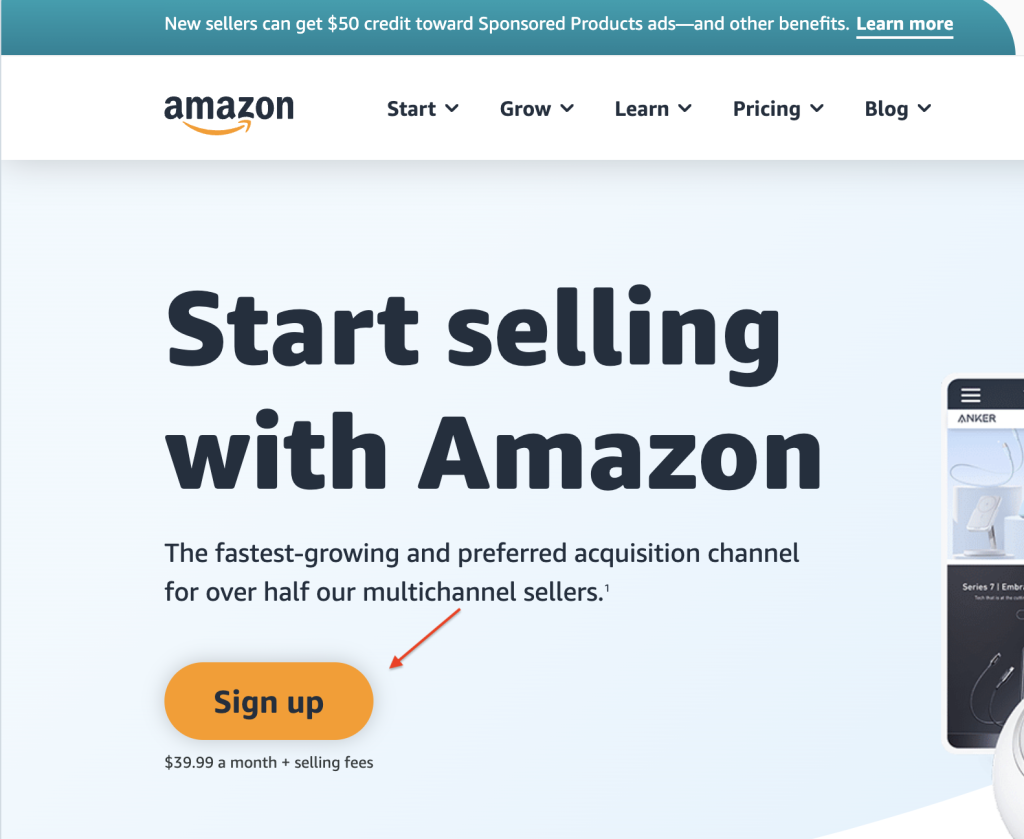
Next, we need to confirm our identity, phone number, and other things. All documents and payment systems should be ready for you, so all that is left is to fill everything out correctly. The first thing we will be asked to do is to select our country of residence. Choose the country of your actual location if you are working as an individual. If your company or account is opened in the USA, choose the USA.
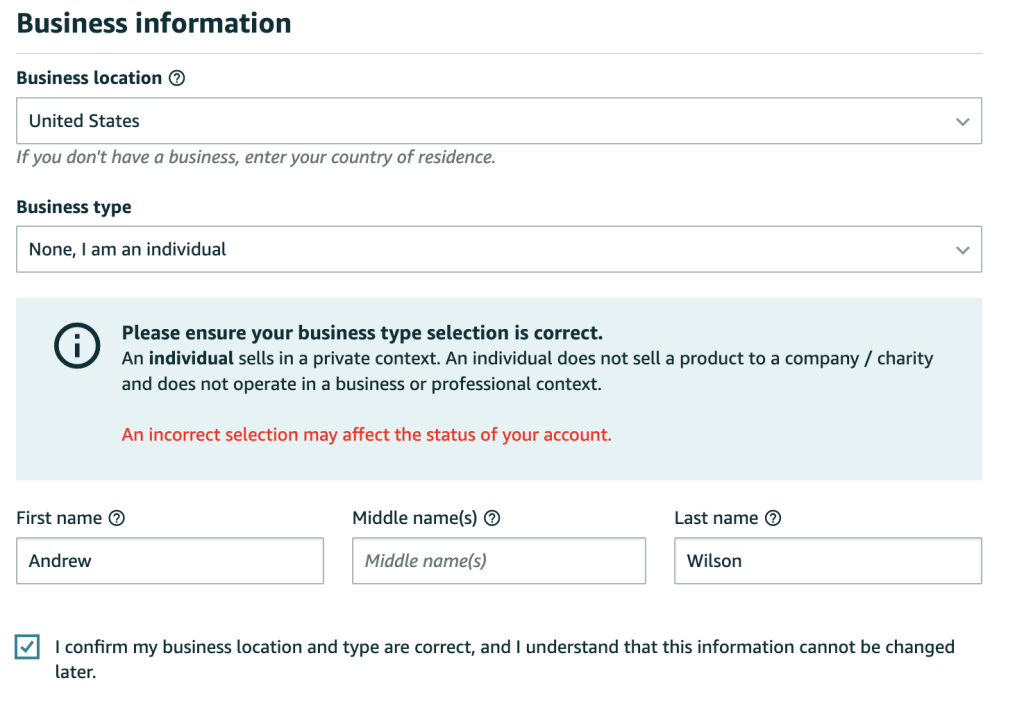
In case you are an individual, choose the type of business Individual, and then enter your first and last name.
Next, you'll have four stages that you need to complete:
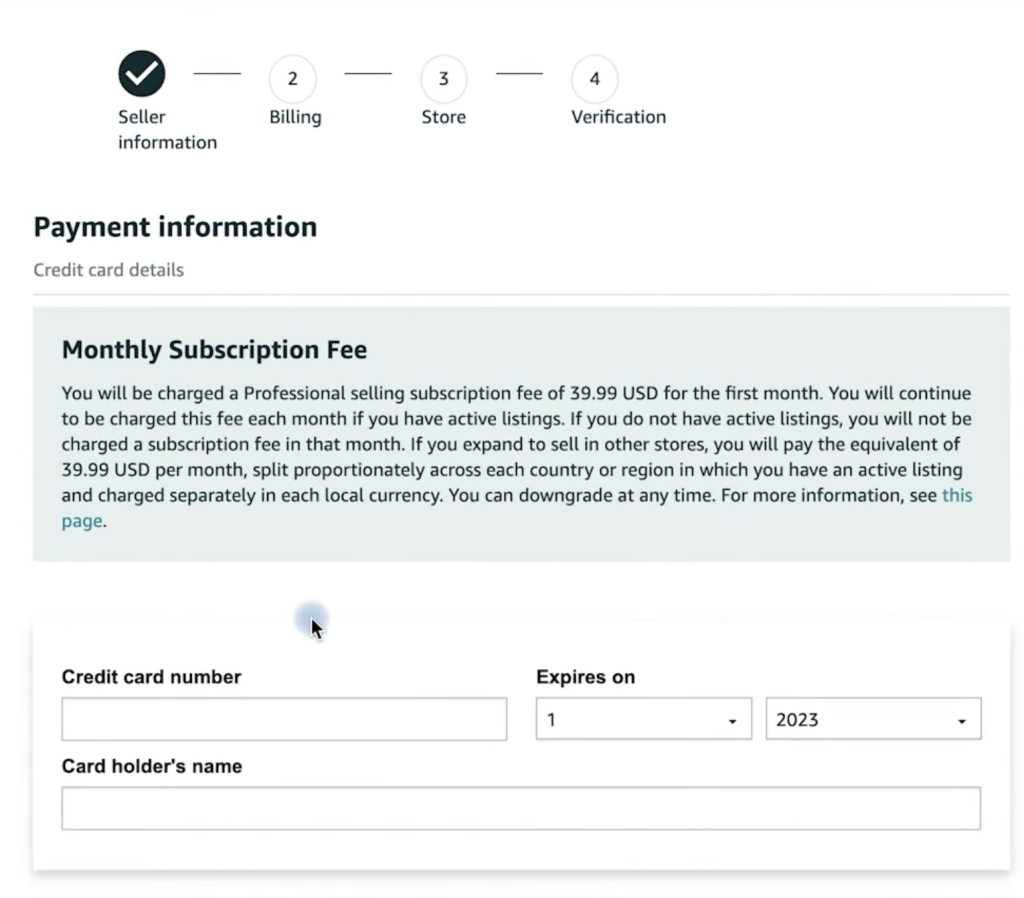
After all the data has been filled in, click “Next”.
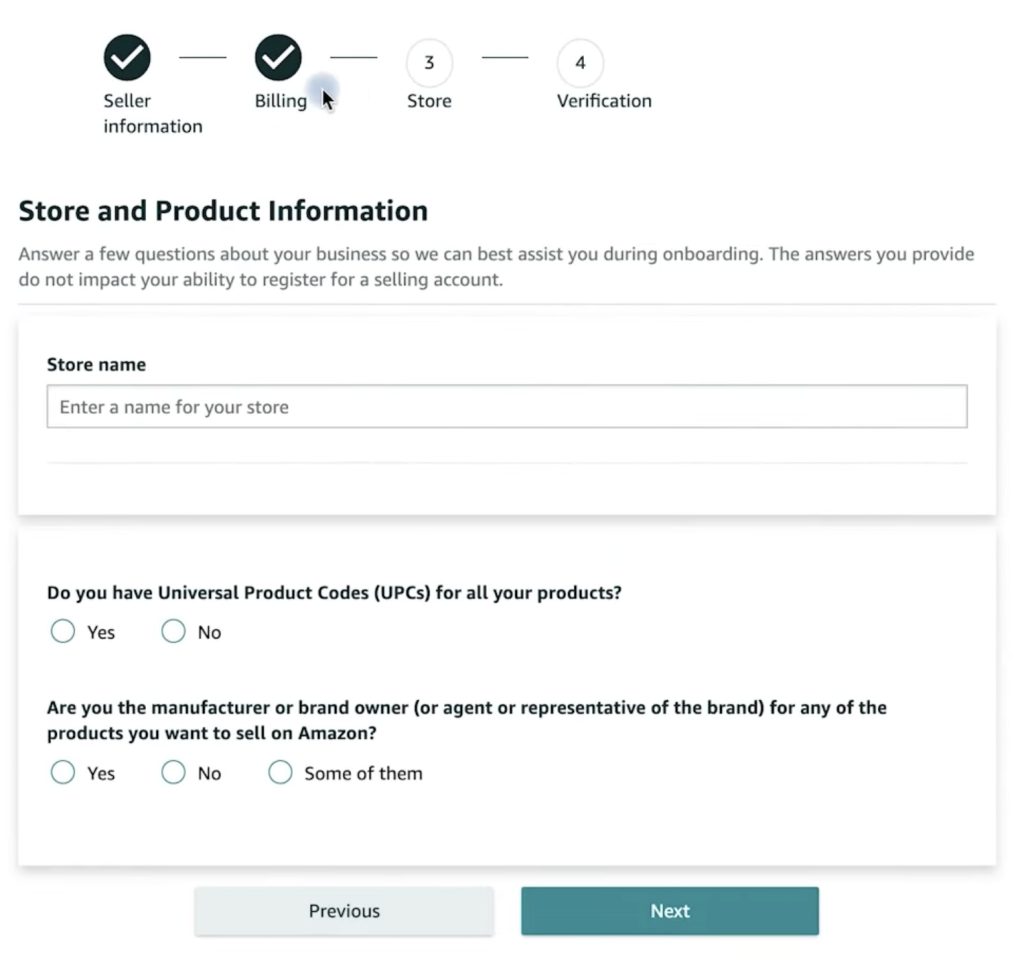
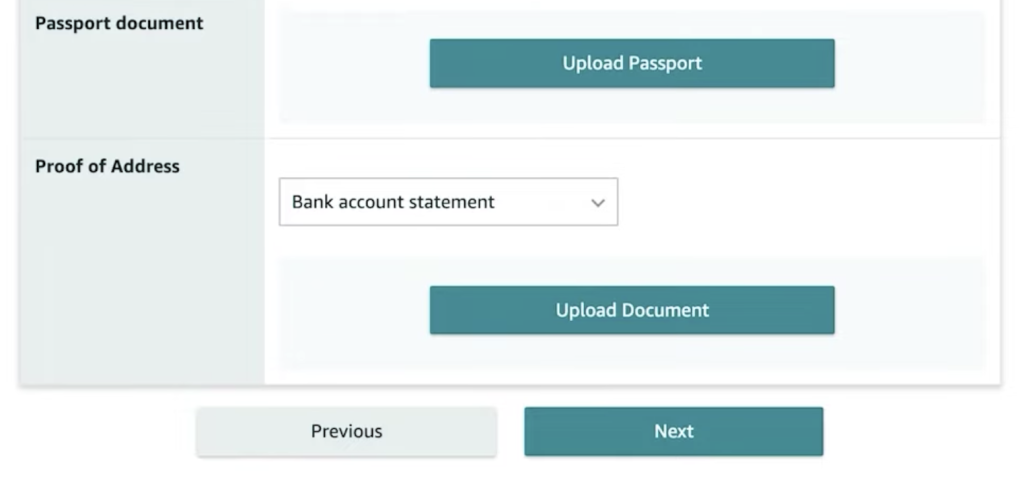
Before starting to use ecommerce proxy the verification stage is waiting for you. After you have successfully completed the registration stages, the most important stage of verification is coming.
In 1-2 days after registration you’ll first of all have your documents verified, namely your passport and bank statement. In case the answer from Amazon is negative for some reason, you are able to re-upload scans of your documents. If you uploaded a photo, try uploading a scan for better quality.
After successful verification of your documents, you may have one or more additional verification steps – Utility Bill, a video call or a mail to the Address you provided during registration. All you need to do in this situation is to follow all the instructions provided by the platform itself and after successful completion you’ll be able to get an Amazon seller account. Although this verification seems to be a problematic moment, perhaps really problematic is only the Utility Bill, where you’ll need to translate into English your utility bills and provide it to the platform, which is not always easy to do, but now there are many companies that help with this issue.
The other two are basically quite simple and probably the fastest and least resource and time consuming. Even if you don't know English, on an Amazon video call it's fine if you have an intermediary with you to help with translation, but basically all you need to do is show your face on camera, your passport and sometimes a bank statement. The letter from the platform is also a fairly easy way to verify, but perhaps the longest, as the letter will have to wait for some time, and to speed up the process is impossible. So follow all the instructions, and the process will be successful.
Where does the arbitration process begin? If you decide to resort to the services of TacticalArbitrage or any other service with similar functionality, you are able to start your product search with these tools using ecommerce proxy:
In TacticalArbitrage you go to the “Product Search” section. You choose the country you are going to work for, in this case we take the USA as a basis.
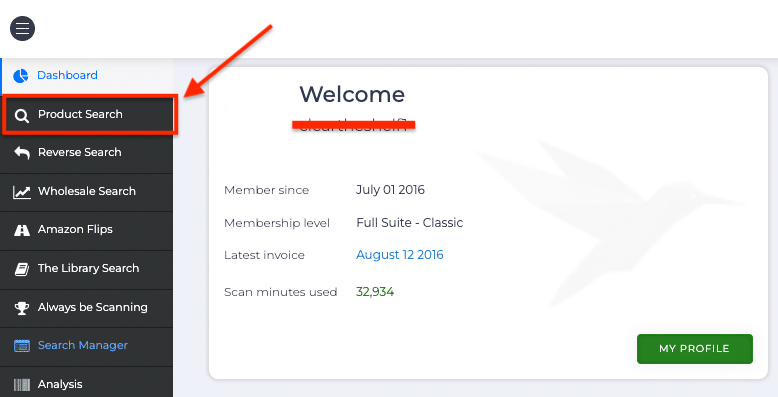
After that, we choose a store from a huge list of proposed options, where we will look for products to resell them.
Since the directions of different stores and categories of goods are many and very many, try to start with something in which you at least superficially understand to look for profitable products there. In the future, as you study the market, you’ll begin to see interesting options even in those areas in which you do not understand much, but the key here is that you’ll learn to see obviously profitable goods in the most niche areas and can expand the list of potential products for purchase.
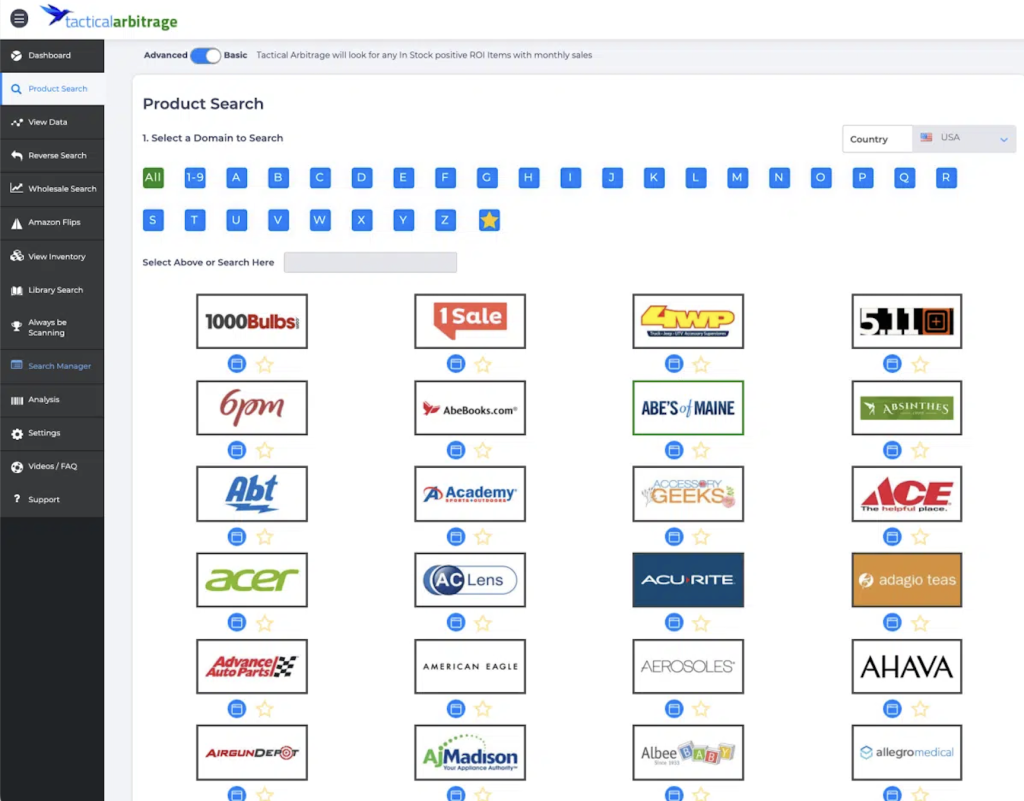
In the “Category Select” section, we select the product category we are interested in and click on the “Search” button. Then the service scans all the information from the selected site and when it is finished, it will give us the result, where we will immediately see the key indicators for us – the difference in price in this store and on Amazon. Accordingly, we can quickly find cheap local products that we can sell more expensively. And you’ll see just a huge number of such goods.
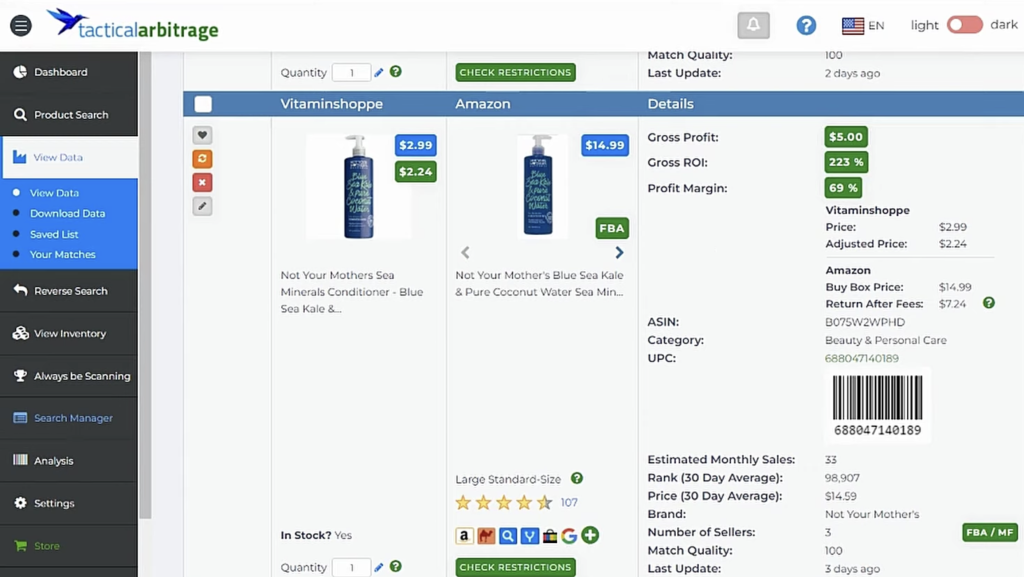
It is recommended at the initial stage not to choose goods with a large mass or large volume, because it can complicate logistics for Amazon, and accordingly drag on additional costs, which at the start you do not really need. But even without such goods you’ll have a more than impressive choice, because you are able to simultaneously scan several stores at once. It is also not recommended to choose too expensive goods at the initial stage, because you can invest quite a lot of money in a product that may have problems when selling and you’ll lose a large part of your budget. Always allocate funds between different categories of goods, because a lot of things in the field of arbitrage becomes clear only with experience, and you can easily both get a solid profit on a certain group of goods, and lose a lot of money.
But do not hurry to celebrate ahead of time, because this is not all the work we need to do to resell the goods profitably using an ecommerce proxy. The reason for this is simple – not all products are in demand in the market. At first glance, there may be thousands and tens of thousands of profitable goods on your list, but there are only a few goods that are in demand and are almost guaranteed to be bought by the client. And your task is to find among this list of such goods. Do not worry, you can do it, it will only require diligence and a certain amount of time. There are quite a few tools that help to separate the goods that are in demand from the goods that are not sold on the market. This is what we are going to talk about.
Here we will need to enlist the help of an extension called SellerAssistantApp, which will show us the rating of the product. If you have this extension enabled, you’ll see a few new fields on the Amazon product page that will help you navigate how potentially profitable the product is and whether it's selling at all. First of all, we are interested in the BSR indicator, which is the sellability rating of the product. The lower the number - the more popular the product is in its segment.
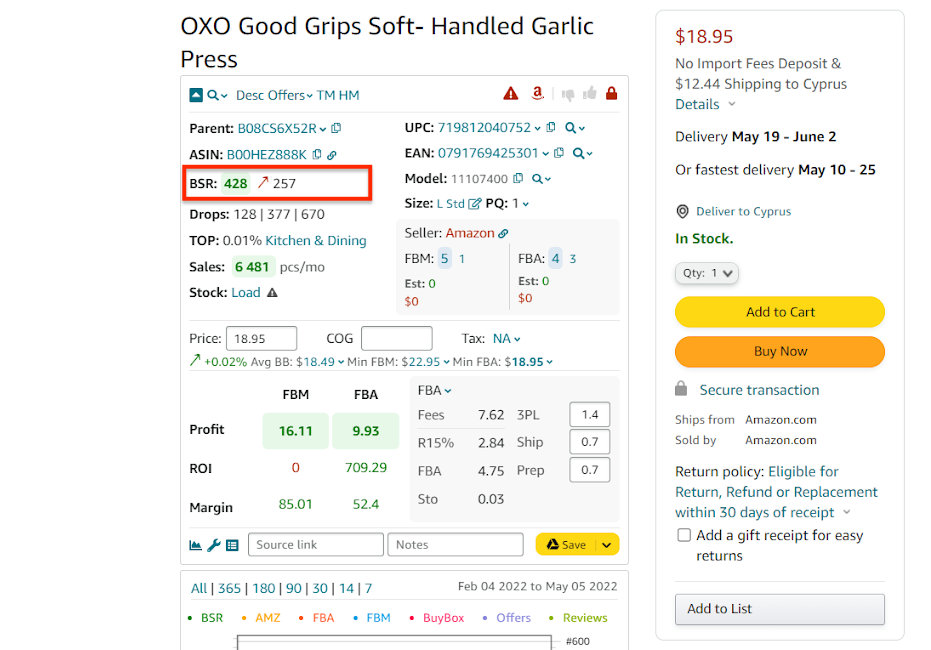
But at the same time, we should also take into account the fact that for each category of goods this position can mean different values. For example, clothing, books, and kitchen products are some of the most popular items on Amazon, respectively, for clothing BSR rating below 1 million is usually the top 1% in this category and this indicates that such a product you are likely to successfully resell. At the same time, a BSR rating of 1 million for a more narrow product category, say Musical Instruments or Grocery & Gourmet Food, will be far outside of even the top 50% of sales on the platform, which automatically means that you are almost guaranteed not to sell such an item.
So your job is to look for items that are ideally in the top 3% and below percent of sales on Amazon, so that you are able to sell those items quickly enough to make a profit while using an ecommerce proxy.
To find out the Sales Rank of the product category you need, you can monitor various current tables on the Internet on this topic, on the request: “amazon sales rank chart” in a Google search with the prefix of the current year, most often you’ll be able to find the current information quickly enough. Also the extension shows this ranking on the product page, so you can also take it as a basis.
Under the product rating below we can see another useful price comparison tool. On the left you’ll see the price of the product on the platform, and on the right in the COG (Cost of Goods) field you can write the price of the product that is listed in the store you found. This aggregator will immediately recalculate the price of the item taking into account Amazon FBA, additional costs and other things and will show your net profit. Therefore, it is also an indispensable thing, because even if you found an obviously profitable product with a good sales ranking but after recalculating all the costs you do not earn anything, then you do not need such a product and need to look further.
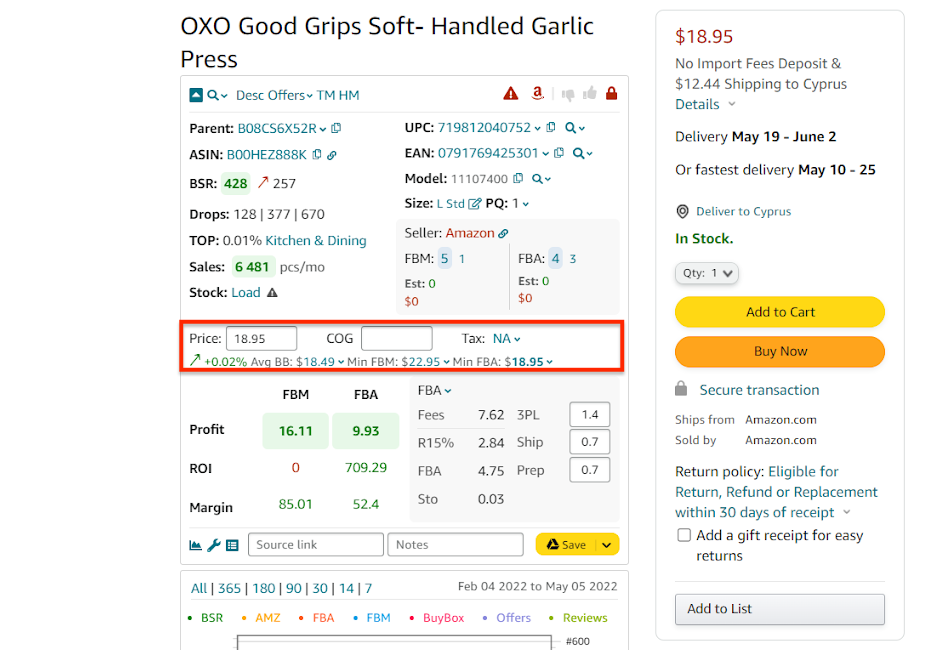
This is roughly how the process of retail arbitrage on Amazon works with ecommerce proxy. You can perform all the same actions on your own without the use of supporting utilities, but it will take you much more time and as a result you’ll make less income. But it is still possible, if you study the market and a certain group of goods well, you can make sales yourself, and there are people who manage to make a profit even selling goods from the mall on the next street, buying them physically and reselling them on platform. So the basis of this model is to understand the market, and once you are well enough immersed in the market you are almost guaranteed to make a good profit.
Next, after you have found a profitable item and have already made the decision to purchase it, you need to send the item to the Prep Center. This also needs to be done because the item needs to be pre-processed before it can be sent to Amazon warehouses. Almost all major Marketplaces have quite strict conditions on packaging, labeling, product integrity and other things. In addition, you’ll be located remotely, so you can not directly deal with the packaging of the product. Therefore, before the goods arrive at the warehouse or any other major marketplace, they must be barcoded, packaged, and if possible, branded. Prep centers are essentially large warehouses where your product is stored for a while before it is sent to Amazon warehouses, packed and branded. These days there are a lot of private companies that help do this part of the work for you, a Google search will show you many different options and help you choose the best one for you.

Also when looking for a product always take into account that some part of the profit will be given to the prep center, usually this amount is up to 1 dollar, depending on the category of goods and the conditions of the prep center.
It's worth mentioning the wholesale sales model separately, because in order to scale your business at some point you’ll inevitably start to consider this option, as buying directly from a supplier is always beneficial. If we look at the financial side of such cooperation, the profit will indeed be much higher. But one of the problems is that you’ll need a rather large start-up budget, because you need to buy products in such a case in large quantities. But an even more significant problem can be a lack of knowledge of the market, you are able to buy products directly in large quantities and it turns out that with the sale of this product there are some problems, so you can get quite a lot of trouble and even financial losses. Therefore, consider this model only if you have a large budget and your business is going to a large scale, as well as a good enough understanding of the market, at least in some of its specific segments or categories of goods.
When it comes to proxies, the range of tasks can be quite extensive – from simple multi-accounting to price comparison or market analysis. To avoid getting an IP ban on Amazon, you’ll need to swap your IP for another one to keep yourself safe. Also, there are quite a few targeted resources that require careful selection of ecommerce proxies and not all of the options on the market can work well for your chosen task.
The point is that it is often not enough to buy just any proxy, for each purpose you need to make an individual selection and choose the appropriate option for your target resource and specifically for your task.
First of all, you’ll only need a private ecommerce proxy, using any public ones, public VPN clients and other things increases the risk of being blocked by the platform. And this will be extremely hurtful in the situation with ecommerce accounts, because after all the stages of verification to get blocked will automatically mean a significant loss in finances. Therefore, when choosing a proxy solution, it’s worth paying attention to the stability and trust level of the network. Private mobile proxies are often preferred for account scaling due to their reliability and rotation flexibility (more details here).
Secondly, you should buy different servers for different tasks. For example, if we want to use them for price comparison, then residential ones will suit us well for this task, because they have the ability to select them by region, city or even ISP. For mass creation of accounts mobile ecommerce proxy will work well, as they are quite trustworthy and at the same time profitable if you need to register a lot of accounts.
Can you use residential proxies anywhere? Yes, indeed. But, in our case, they are highly beneficial in the ecommerce arbitrage. For those focusing specifically on Amazon trading, best Amazon proxies help maintain smooth performance and correct marketplace targeting.
But there are also quite a few resources under which regular static Datacenter IPv4 or even IPv6 ecommerce proxy will work well, and it makes no sense for you to buy a more expensive solution. That's why you should choose them exclusively for your task, and not only for the target resource. For this purpose we recommend you to contact us in online chat before purchasing, where our consultants work round the clock for this purpose to help you find the most suitable option for your task.
Overall, this is exactly how ecommerce arbitrage works using Amazon as an example. But these principles apply to any other major marketplaces, and often even tools like TacticalArbitrage work for several major platforms at once. The most important thing is that with an understanding of how ecommerce arbitrage works you can safely start working in this field, as it is completely legal and from the first account you create you can start earning here and now. But when scaling up, always remember your safety and that by saving on things like ecommerce proxy you risk losing more in the future. So invest wisely not only in the products you sell, but also in any auxiliary tools for work.
Comments: 0